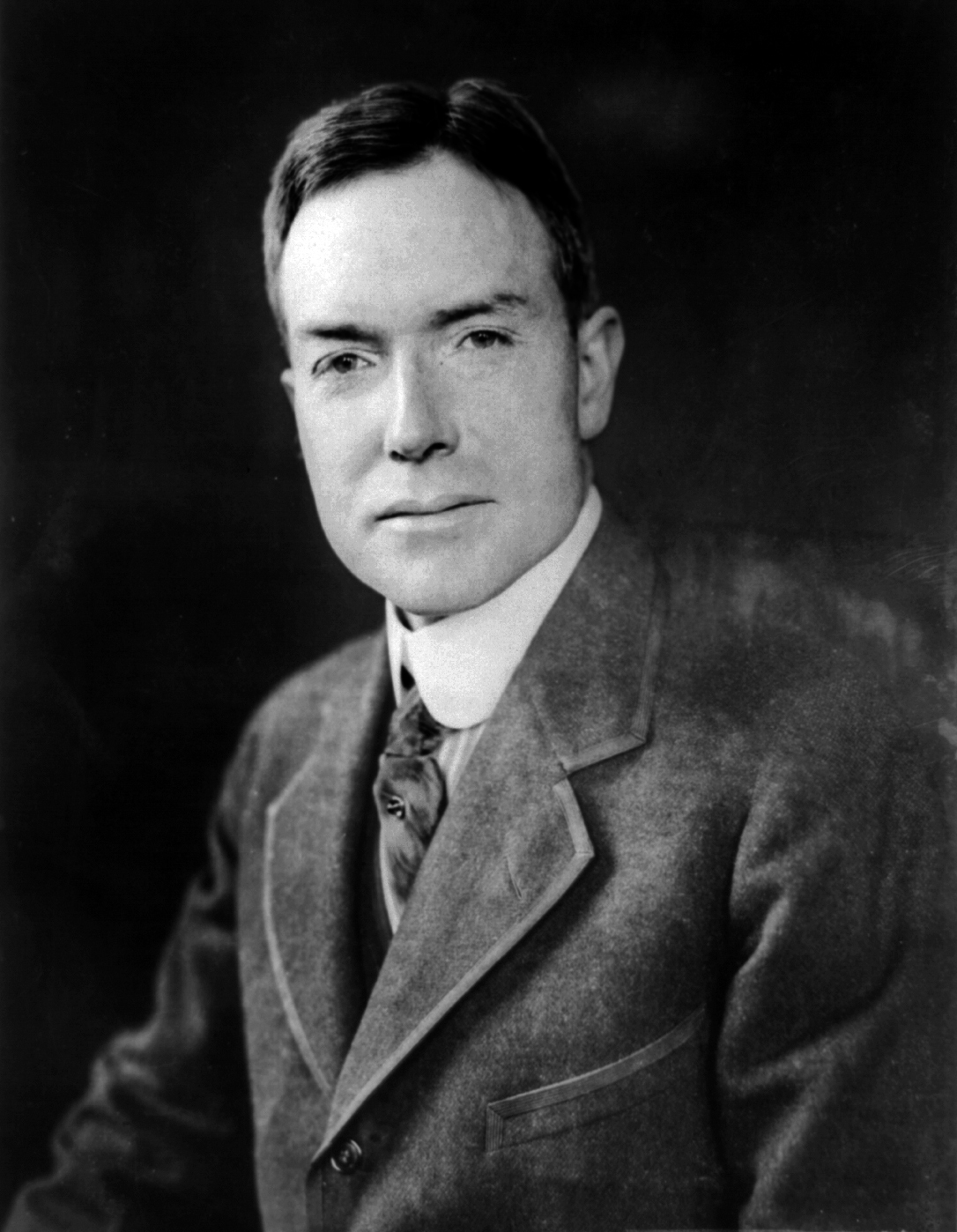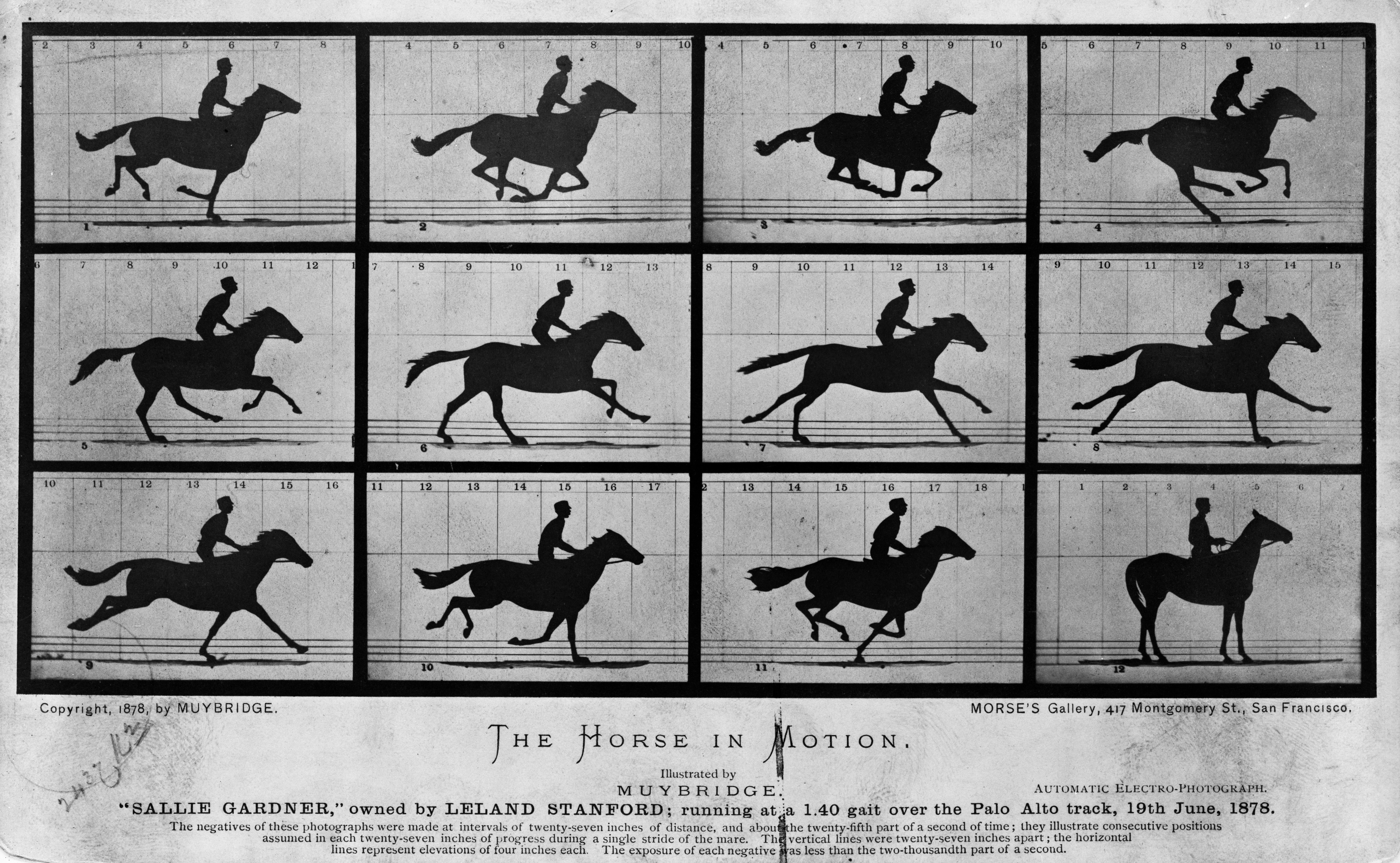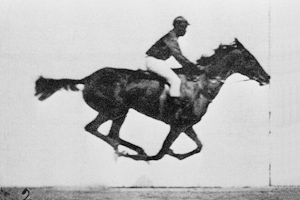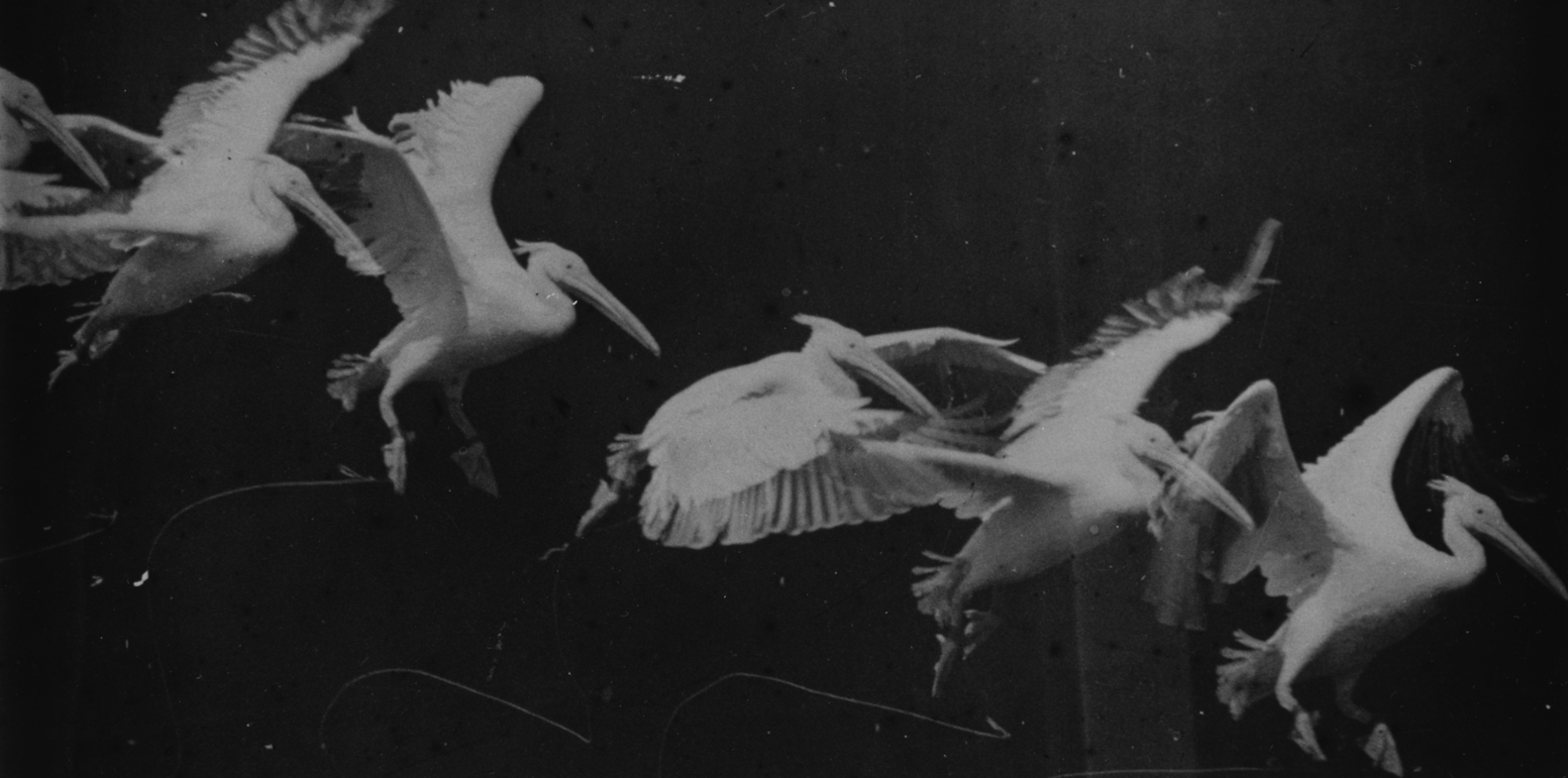|
Janssen Revolver
The Janssen revolver () was invented by the French astronomer Pierre Jules César Janssen in 1874. It was the instrument that originated chronophotography, a branch of photography based on capturing movement from a sequence of images. To create the apparatus Pierre Janssen was inspired by the revolving cylinder of Samuel Colt's revolver. Usage The revolver used two discs and a sensitive plate, the first with twelve holes ( shutter) and the second with only one, on the plate. The first one would take a full turn every eighteen seconds, so that each time a shutter window passed in front of the window of the second (fixed) disk, the sensitive plate was discovered in the corresponding portion of its surface, creating an image. In order for the images not to overlap, the sensitive plate rotated with a quarter of the shutter speed. The Shutter Speed was one and a half seconds. A mirror on the outside of the apparatus reflected the movement of the object towards the lens that was loc ... [...More Info...] [...Related Items...] OR: [Wikipedia] [Google] [Baidu] |
Nagasaki
, officially , is the capital and the largest Cities of Japan, city of Nagasaki Prefecture on the island of Kyushu in Japan. Founded by the Portuguese, the port of Portuguese_Nagasaki, Nagasaki became the sole Nanban trade, port used for trade with the Portuguese and Dutch during the 16th through 19th centuries. The Hidden Christian Sites in the Nagasaki Region have been recognized and included in the World Heritage Sites in Japan, UNESCO World Heritage Sites list. Part of Nagasaki was home to a major Imperial Japanese Navy base during the First Sino-Japanese War and Russo-Japanese War. Near the end of World War II, the American atomic bombings of Hiroshima and Nagasaki made Nagasaki the second city in the world to experience a nuclear attack. The city was rebuilt. , Nagasaki has an estimated population of 392,281, and a population density of 966 people per km2. The total area is . History Nagasaki as a Jesuit port of call The first recorded contact between Portuguese e ... [...More Info...] [...Related Items...] OR: [Wikipedia] [Google] [Baidu] |
1870s In Film
The decade of the 1870s in film involved some significant events. Events *1874 – French astronomer Pierre Janssen Pierre Jules César Janssen (22 February 1824 – 23 December 1907), usually known as Jules Janssen, was a French astronomer who, along with English scientist Joseph Norman Lockyer, is credited with discovering the gaseous nature of the solar ... used his Janssen revolver to photograph the Passage de Venus, transit of the planet Venus across the Sun. *1877 – French inventor Charles-Émile Reynaud improved on the Zoetrope idea by placing mirrors at the center of the drum. He called his invention the Praxinoscope. Reynaud developed other versions of the Praxinoscope, too, including a Praxinoscope Theatre (where the device was enclosed in a viewing box) and the Projecting Praxinoscope. Eventually he created the "Théâtre Optique", a large machine based on the Praxinoscope, able to project longer animated strips. In the United States, the McLoughlin Brothers, ... [...More Info...] [...Related Items...] OR: [Wikipedia] [Google] [Baidu] |
1874 Introductions
Events January * January 1 – New York City annexes The Bronx. * January 2 – Ignacio María González becomes head of state of the Dominican Republic for the first time. * January 3 – Third Carlist War: Battle of Caspe – Campaigning on the Ebro in Aragon for the Spanish Republican Government, Colonel Eulogio Despujol surprises a Carlist force under Manuel Marco de Bello at Caspe, northeast of Alcañiz. In a brilliant action the Carlists are routed, losing 200 prisoners and 80 horses, while Despujol is promoted to Brigadier and becomes Conde de Caspe. * January 20 – The Pangkor Treaty (also known as the Pangkor Engagement), by which the British extend their control over first the Sultanate of Perak, and later the other independent Malay States, is signed. * January 23 – Prince Alfred, Duke of Edinburgh, second son of Queen Victoria, marries Grand Duchess Maria Alexandrovna of Russia, only daughter of Tsar Alexander III of Russia, in the ... [...More Info...] [...Related Items...] OR: [Wikipedia] [Google] [Baidu] |
Camcorder
A camcorder is a self-contained portable electronic device with video and recording as its primary function. It is typically equipped with an articulating screen mounted on the left side, a belt to facilitate holding on the right side, hot-swappable battery facing towards the user, hot-swappable recording media, and an internally contained quiet optical zoom lens. The earliest camcorders were tape-based, recording analog signals onto videotape cassettes. In the 2000s, digital recording became the norm, and additionally tape was replaced by storage media such as mini- HDD, MiniDVD, internal flash memory and SD cards. More recent devices capable of recording video are camera phones and digital cameras primarily intended for still pictures, whereas dedicated camcorders are often equipped with more functions and interfaces than more common cameras, such as an internal optical zoom lens that is able to operate silently with no throttled speed, whereas cameras with protract ... [...More Info...] [...Related Items...] OR: [Wikipedia] [Google] [Baidu] |
Tracking Shot
In cinematography, a tracking shot is any shot where the camera follows backward, forward or moves alongside the subject being recorded. Mostly the camera’s position is parallel to the character, creating a sideway motion, tracking the character. Tracking shots (also called travel shots) differ in motion from dolly shots, where the camera follows behind or before the character resulting in either an inward or an outward movement. Often the camera is mounted on a camera dolly which rides on rails similar to a railroad track; in this case, the shot is referred to as a dolly shot. A handheld steadycam or gimbal may also be used for smaller scale productions. The camera is then pushed along the track while the scene is being filmed, or moved manually when using a handheld rig. The effect can be used to create a sense of movement, to follow a character or object, or a sense of immersion to draw the viewer into the action. The technique is often used to follow a subject that would ... [...More Info...] [...Related Items...] OR: [Wikipedia] [Google] [Baidu] |
The Horse In Motion
''The Horse in Motion'' is a series of cabinet cards by Eadweard Muybridge, including six cards that each show a series of six to twelve "automatic electro-photographs" depicting successive phases in the movement of a horse, shot in June 1878. An additional card reprinted the single image of the horse "Occident" trotting at high speed, which had already been published in 1877. The series became the first example of chronophotography, an early method to photography, photographically record the passing of time, mainly used to document the different phases of locomotion for scientific study. It formed a very influential step in the development of Film, motion pictures. One of the cards (often retitled ''Sallie Gardner at a Gallop'') has even been hailed as "the world's first bit of cinema". Muybridge did project moving images from his photographs with his Zoopraxiscope, from 1880 to 1895, but these were painted on discs and his technology was no more advanced than earlier effor ... [...More Info...] [...Related Items...] OR: [Wikipedia] [Google] [Baidu] |
Eadweard Muybridge
Eadweard Muybridge ( ; 9 April 1830 – 8 May 1904, born Edward James Muggeridge) was an English photographer known for his pioneering work in photographic studies of motion, and early work in motion-picture Movie projector, projection. He adopted the first name "Eadweard" as the original Germanic name, Anglo-Saxon form of "Edward", and the surname "Muybridge", believing it to be similarly archaic. A photographer in the 19th century American West, he photographed Yosemite National Park, Yosemite, San Francisco, the newly acquired Alaska, Alaskan Territory, subjects involved in the Modoc War, and lighthouses on the West Coast of the United States, West Coast. He also made his early moving picture studies in California. Born in Kingston upon Thames, Surrey, England, at the age of 20 he emigrated to the United States as a bookseller, first to New York City, then to San Francisco. In 1860, he planned a return trip to Europe, but suffered serious head injuries en route in a sta ... [...More Info...] [...Related Items...] OR: [Wikipedia] [Google] [Baidu] |
Étienne-Jules Marey
Étienne-Jules Marey (; 5 March 1830, Beaune, Côte-d'Or – 15 May 1904, Paris) was a French scientist, physiologist and chronophotographer. His work was significant in the development of cardiology, physical instrumentation, aviation, cinematography and the science of laboratory photography. He is widely considered to be a pioneer of photography and an influential pioneer of the history of cinema. He was also a pioneer in establishing a variety of graphical techniques for the display and interpretation of quantitative data from physiological measurement. Biography Marey started by studying blood circulation in the human body. Then he shifted to analyzing heart beats, respiration, muscles (myography), and movement of the body. To aid his studies he developed many instruments for precise measurements. For example, in 1859, in collaboration with the physiologist Auguste Chauveau and the watch manufacturer Breguet, he developed a wearable ''Sphygmograph'' to measure the puls ... [...More Info...] [...Related Items...] OR: [Wikipedia] [Google] [Baidu] |
French Academy Of Sciences
The French Academy of Sciences (, ) is a learned society, founded in 1666 by Louis XIV at the suggestion of Jean-Baptiste Colbert, to encourage and protect the spirit of French Scientific method, scientific research. It was at the forefront of scientific developments in Europe in the 17th and 18th centuries, and is one of the earliest Academy of Sciences, Academies of Sciences. Currently headed by Patrick Flandrin (President of the academy), it is one of the five Academies of the . __TOC__ History The Academy of Sciences traces its origin to Colbert's plan to create a general academy. He chose a small group of scholars who met on 22 December 1666 in the King's library, near the present-day Bibliothèque nationale de France, Bibliothèque Nationale, and thereafter held twice-weekly working meetings there in the two rooms assigned to the group. The first 30 years of the academy's existence were relatively informal, since no statutes had as yet been laid down for the ins ... [...More Info...] [...Related Items...] OR: [Wikipedia] [Google] [Baidu] |
Société Française De Photographie
The Société française de photographie (SFP) is an association, founded on 15 November 1854, devoted to the history of photography. It has a large collection of photographs and old cameras. Among the founding members were Olympe Aguado, Hippolyte Bayard, Alexandre Edmond Becquerel, Eugène Durieu, Edmond Fierlants, Jean-Baptiste Louis Gros, Gustave Le Gray and Henri Victor Regnault. Henri Victor Regnault was the first president. Louise Leghait was the first woman member. History The Société française de photographie, founded on 15 November 1854, was based on the short-lived Société héliographique (1851) but differed in that it was less elitist and more forward-looking. Some accounts mistakenly link the two organizations more closely, referring simply to a change in the name with a view to giving the SFP the status of the world's oldest photography organization. A careful analysis of the Société héliographique describes in detail how the initial enthusiasm for the organi ... [...More Info...] [...Related Items...] OR: [Wikipedia] [Google] [Baidu] |
Daguerreotype
Daguerreotype was the first publicly available photography, photographic process, widely used during the 1840s and 1850s. "Daguerreotype" also refers to an image created through this process. Invented by Louis Daguerre and introduced worldwide in 1839, the daguerreotype was almost completely superseded by 1856 with new, less expensive processes, such as ambrotype (collodion process), that yield more readily viewable images. There has been a revival of the daguerreotype since the late 20th century by a small number of photographers interested in making artistic use of early photographic processes. To make the image, a daguerreotypist polished a sheet of Plating#Silver plating, silver-plated copper to a mirror finish; treated it with fumes that made its surface light-sensitive; exposure (photography), exposed it in a camera obscura, camera for as long as was judged to be necessary, which could be as little as a few seconds for brightly sunlit subjects or much longer with less ... [...More Info...] [...Related Items...] OR: [Wikipedia] [Google] [Baidu] |








